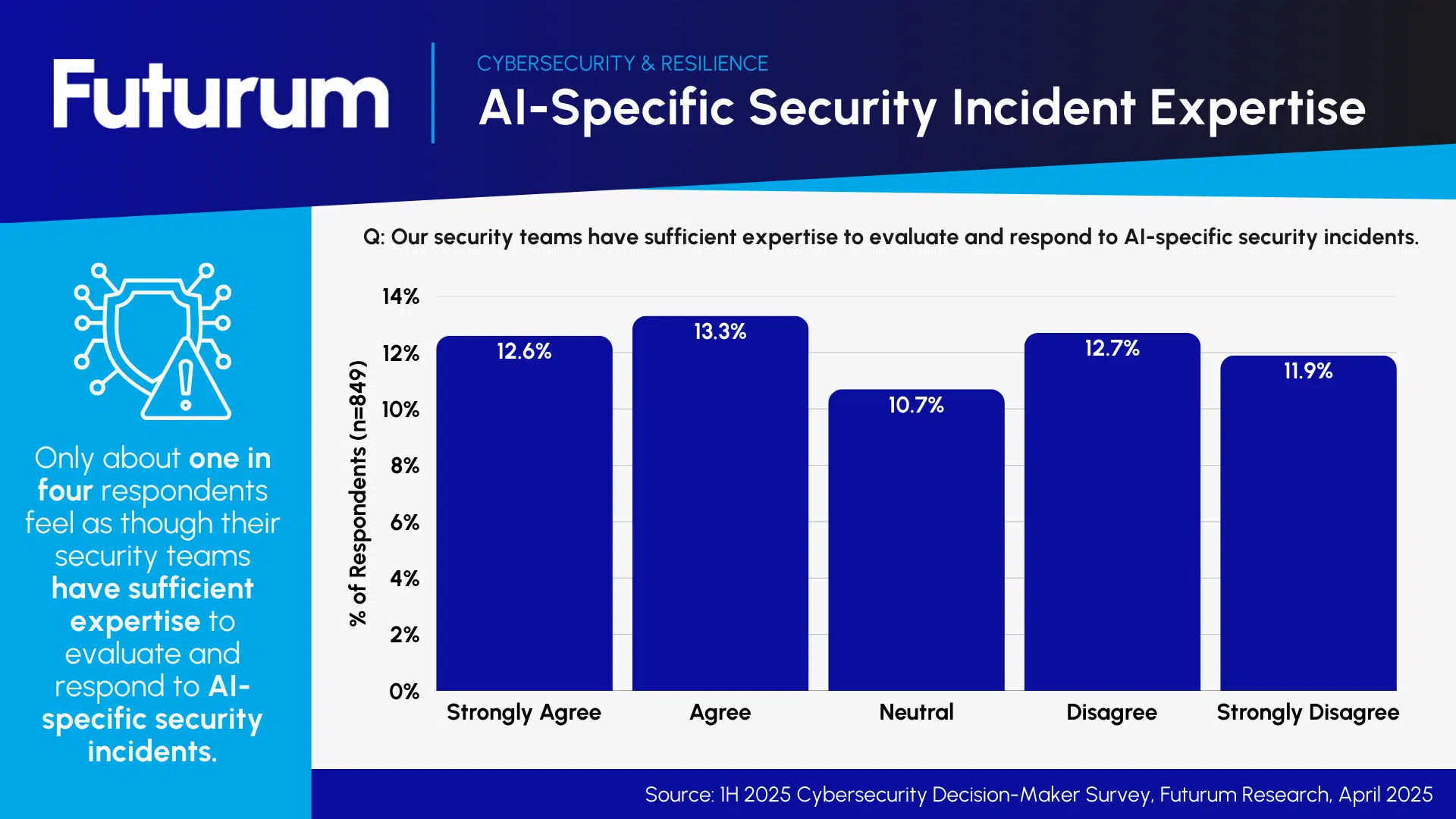AI Research
Futurum Research: AI Security Skills Gap Persists

Austin, Texas, USA, August 26, 2025
Futurum’s 1H25 Cybersecurity Decision Maker Study Reveals That Only About One in Four Organizations Feel Equipped To Respond to AI-Driven Threats
Futurum’s 1H25 Cybersecurity Decision Maker Research reveals that organizations have begun taking steps to address the new security risks that are associated with artificial intelligence (AI) and machine learning (ML). With AI adoption occurring across industries, security leaders recognize that the same technologies enabling innovation also introduce new and complex threat vectors.
More than 25% of surveyed organizations have implemented dedicated AI/ML security controls and processes to evaluate and monitor AI-related vulnerabilities. This reflects a growing awareness that traditional security frameworks must evolve to address the unique risks posed by AI systems, spanning adversarial attacks on machine learning models to data poisoning and manipulation of generative AI outputs.
The study also found one-quarter of respondents acknowledge the presence of AI-powered attacks in today’s threat landscape, and even more expect these incidents to increase over the next 12 months. This expectation is not unfounded; threat actors leverage AI to automate attack planning, enhance phishing sophistication, evade detection, and identify exploitable weaknesses faster. As AI-driven tools become more accessible, the barrier to entry for launching sophisticated cyberattacks drops.
Figure 1: AI-Specific Security Incident Expertise
The growing speed and sophistication of malicious actors results in a notable skills gap. In Futurum’s study, only about one in four respondents felt their security teams are adequately equipped to handle AI-specific security incidents. This shortfall implies challenges in building or acquiring the specialized expertise needed to respond effectively to emerging AI threats.
“AI is transforming both innovation and the threat landscape. Our research shows that while organizations are moving to secure AI, the skills gap remains an important hurdle to overcome,” said Fernando Montenegro, VP and Practice Lead at Futurum.
AI-related security tooling can also help to close this skills gap. However, decision makers require transparency in order to verify that AI itself does not become a point of vulnerability. In fact, many decision makers in Futurum’s study indicated that they require vendors to disclose whether their products use AI and to detail the controls in place to secure that usage.
The findings point to a broader industry challenge: keeping pace with the dual forces of growing AI adoption and the evolution of related security concerns. While investment in AI-driven innovation will only increase, security programs must evolve in parallel to prevent innovation from outpacing protection. Failure to do so risks leaving organizations vulnerable to the very technologies they are adopting to gain competitive advantage.
“The adoption of AI demands an adaptation in the security strategy. To remain secure, organizations must invest in new tools with transparent and explainable usage of AI,” said Krista Case, Research Director at Futurum.
Overall, Futurum’s research paints a picture of a cybersecurity landscape in transition. Leaders are aware of the AI threat, are beginning to implement the necessary controls, and are demanding greater transparency from vendors. Yet, they are also grappling with the reality that AI necessitates not just new tools, but new skills, processes, and collaborative approaches to safeguard the future of digital business.
Read more in the 1H 2025 Cybersecurity Decision-Maker Survey Report on the Futurum Intelligence Platform.
About Futurum Intelligence for Market Leaders
Futurum Intelligence’s Cybersecurity and Resilience IQ service provides actionable insight from analysts, reports, and interactive visualization datasets, helping leaders drive their organizations through transformation and business growth. Subscribers can log into the platform at https://app.futurumgroup.com/, and non-subscribers can find additional information at Futurum Intelligence.
Follow news and updates from Futurum on X and LinkedIn using #Futurum. Visit the Futurum Newsroom for more information and insights.
Declaration of generative AI and AI-assisted technologies in the writing process: During the preparation of this work, the authors used Chat GPT to support editing and writing. After using this tool/service, the authors reviewed and edited the content as needed and take full responsibility for the publication’s content.
Other Insights from Futurum:
SailPoint Bolsters SaaS Security with Savvy Acquisition
Palo Alto Networks Makes Bold $25B Identity Play with CyberArk Deal
Security Summer Camp: Black Hat 2025, Def Con, And Others
AI Research
Palantir CEO Alex Karp says U.S. labor workers won’t lose their jobs to AI—‘it’s not true’

As fears swirl that American manufacturing workers and skilled laborers may soon be replaced by artificial intelligence and robots, Alex Karp, CEO of the AI and data analytics software company Palantir Technologies, hopes to change the narrative.
“It’s not true, and in fact, it’s kind of the opposite,” Karp said in an interview with Fortune Thursday at the company’s commercial customer conference, AIPCon, where Palantir customers showcased how they were using the company’s software platform and generative AI within their own businesses at George Lucas’ Skywalker Ranch in Marin County, Calif.
The primary danger of AI in this country, says Karp, is that workers don’t understand that AI will actually help them in their roles—and it will hardly replace them. “Silicon Valley’s done an immensely crappy job of explaining that,” he said. “If you’re in manufacturing, in any capacity: You’re on the assembly line, you maintain a complicated machine—you have any kind of skilled labor job—the way we do AI will actually make your job more valuable and make you more valuable. But currently you would think—just roaming around the country, and if you listen to the AI narratives coming out of Silicon Valley—that all these people are going to lose their jobs tomorrow.”
Karp made these comments the day before the Bureau of Labor Statistics released its August jobs report, which showcased a climbing unemployment rate and stagnating hiring figures, reigniting fears of whether AI is at all responsible for the broader slowdown. There has been limited data thus far suggesting that generative AI is to blame for the slowing jobs market—or even job cuts for that matter—though a recent ADP hiring report offered a rare suggestion that AI may be one of several factors influencing hiring sentiment. Some executives, including Salesforce’s Marc Benioff, have cited the efficiency gains of AI for layoffs at their companies, and others, like Ford CEO Jim Farley and Amazon CEO Andy Jassy, have made lofty predictions about how AI is on track to replace jobs in the future. Most of these projections have been centered around white collar roles, in particular, versus manufacturing or skilled labor positions.
Karp, who has a PhD in neoclassical social theory and a reputation for being outspoken and contrarian on many issues, argues that fears of AI eliminating skilled labor jobs are unfounded—and he’s committed to “correcting” the public perception.
Earlier this week, Palantir launched “Working Intelligence: The AI Optimism Project,” a quasi-public information and marketing campaign centered around artificial intelligence in the workplace. The project has begun with a series of short blog posts featuring Palantir’s customers and their opinions on AI, as well as a “manifesto” that takes aim at both the “doomers” and “pacifiers” of AI. “Doomers fear, and pacifiers welcome, a future of conformity: a world in which AI flattens human difference. Silicon Valley is already selling such bland, dumbed-down slop,” the manifesto declares, arguing that the true power of AI is not to standardize but to “supercharge” workers.
Jordan Hirsch, who is spearheading the new project at Palantir, said that there are approximately 20 people working on it and that they plan to launch a corresponding podcast.
While Palantir has an obvious commercial interest in dispelling public fears about AI, Karp framed his commitment to the project as something important for society. Fears about job replacement will “feed a kind of weird populism based on a notion that’s not true—that’s going to make the factions on the right and left much, much, much more powerful based on something that’s not true,” he said. “I think correcting that—but not just by saying platitudes, but actually showing how this works, is one of the most important things we have to get on top of.”
Karp said he planned to invest “lots of energy and money” into the AI Optimism Project. When asked how much money, he said he didn’t know yet, but that “we have a lot of money, and it’s one of my biggest priorities.”
Palantir has seen enormous growth within the commercial side of its business in the last two years, largely due to the artificial intelligence product it released in 2023, called “AIP.” Palantir’s revenue surpassed $1 billion for the first time last quarter. And while Palantir only joined the S&P 500 last year, it now ranks as one of the most valuable companies in the world thanks to its soaring stock price.
AI Research
Delaware Partnership to Build AI Skills in Students, Workers

Delaware has announced a partnership with OpenAI on its certification program, which aims to build AI skills in the state among students and workers alike.
The Diamond State’s officials have been exploring how to move forward responsibly with AI, establishing a generative AI policy this year to help inform safe use among public-sector employees, which one official said was the “first step” to informing employees about acceptable AI use. The Delaware Artificial Intelligence Commission also took action this year to advance a “sandbox” environment for testing new AI technologies including agentic AI; the sandbox model has proven valuable for governments across the U.S., from San Jose to Utah.
The OpenAI Certification Program aims to address a common challenge for states: fostering AI literacy in the workforce and among students. It builds on the OpenAI Academy, an open-to-all initiative launched in an effort to democratize knowledge about AI. The initiative’s expansion will enable the company to offer certifications based upon levels of AI fluency, from the basics to prompt engineering. The company is committing to certifying 10 million Americans by 2030.
“As a former teacher, I know how important it is to give our students every advantage,” Gov. Matt Meyer said in a statement. “As Governor, I know our economy depends on workers being ready for the jobs of the future, no matter their zip code.”
The partnership will start with early-stage programming across schools and workforce training programs in Delaware in an effort led by the state’s new Office of Workforce Development, which was created earlier this year. The office will work with schools, colleges and employers in coming months to identify pilot opportunities for this programming, to ensure that every community in the state has access.
Delaware will play a role in shaping how certifications are rolled out at the community level because the program is in its early stages and Delaware is one of the first states to join, per the state’s announcement.
“We’ll obviously use AI to teach AI: anyone will be able to prepare for the certification in ChatGPT’s Study mode and become certified without leaving the app,” OpenAI’s CEO of Applications Fidji Simo said in an article.
This announcement comes on the heels of the federal AI Action Plan’s release. The plan, among other content potentially limiting states’ regulatory authority, aims to invest in skills training and AI literacy.
“By boosting AI literacy and investing in skills training, we’re equipping hardworking Americans with the tools they need to lead and succeed in this new era,” U.S. Secretary of Labor Lori Chavez-DeRemer said in a statement about the federal plan.
Delaware’s partnership with OpenAI for its certification program mirrors this goal, equipping Delawareans with the knowledge to use these tools — in the classroom, in their careers and beyond.
AI skills are a critical part of broader digital literacy efforts; today, “even basic digital skills include AI,” National Digital Inclusion Alliance Director Angela Siefer said earlier this summer.
AI Research
The End of Chain-of-Thought? CoreThink and University of California Researchers Propose a Paradigm Shift in AI Reasoning

For years, the race in artificial intelligence has been about scale. Bigger models, more GPUs, longer prompts. OpenAI, Anthropic, and Google have led the charge with massive large language models (LLMs), reinforcement learning fine-tuning, and chain-of-thought prompting—techniques designed to simulate reasoning by spelling out step-by-step answers.
But a new technical white paper titled CoreThink: A Symbolic Reasoning Layer to reason over Long Horizon Tasks with LLMs from CoreThink AI and University of California researchers argues that this paradigm may be reaching its ceiling. The authors make a provocative claim: LLMs are powerful statistical text generators, but they are not reasoning engines. And chain-of-thought, the method most often used to suggest otherwise, is more performance theater than genuine logic.
In response, the team introduces General Symbolics, a neuro-symbolic reasoning layer designed to plug into existing models. Their evaluations show dramatic improvements across a wide range of reasoning benchmarks—achieved without retraining or additional GPU cost. If validated, this approach could mark a turning point in how AI systems are designed for logic and decision-making.
What Is Chain-of-Thought — and Why It Matters
Chain-of-thought (CoT) prompting has become one of the most widely adopted techniques in modern AI. By asking a model to write out its reasoning steps before delivering an answer, researchers found they could often improve benchmark scores in areas like mathematics, coding, and planning. On the surface, it seemed like a breakthrough.
Yet the report underscores the limitations of this approach. CoT explanations may look convincing, but studies show they are often unfaithful to what the model actually computed, rationalizing outputs after the fact rather than revealing true logic. This creates real-world risks. In medicine, a plausible narrative may mask reliance on spurious correlations, leading to dangerous misdiagnoses. In law, fabricated rationales could be mistaken for genuine justifications, threatening due process and accountability.
The paper further highlights inefficiency: CoT chains often grow excessively long on simple problems, while collapsing into shallow reasoning on complex ones. The result is wasted computation and, in many cases, reduced accuracy. The authors conclude that chain-of-thought is “performative, not mechanistic”—a surface-level display that creates the illusion of interpretability without delivering it.
Symbolic AI: From Early Dreams to New Revivals
The critique of CoT invites a look back at the history of symbolic AI. In its earliest decades, AI research revolved around rule-based systems that encoded knowledge in explicit logical form. Expert systems like MYCIN attempted to diagnose illnesses by applying hand-crafted rules, and fraud detection systems relied on vast logic sets to catch anomalies.
Symbolic AI had undeniable strengths: every step of its reasoning was transparent and traceable. But these systems were brittle. Encoding tens of thousands of rules required immense labor, and they struggled when faced with novel situations. Critics like Hubert Dreyfus argued that human intelligence depends on tacit, context-driven know-how that no rule set could capture. By the 1990s, symbolic approaches gave way to data-driven neural networks.
In recent years, there has been a renewed effort to combine the strengths of both worlds through neuro-symbolic AI. The idea is straightforward: let neural networks handle messy, perceptual inputs like images or text, while symbolic modules provide structured reasoning and logical guarantees. But most of these hybrids have struggled with integration. Symbolic backbones were too rigid, while neural modules often undermined consistency. The result was complex, heavy systems that failed to deliver the promised interpretability.
General Symbolics: A New Reasoning Layer
CoreThink’s General Symbolics Reasoner (GSR) aims to overcome these limitations with a different approach. Instead of translating language into rigid formal structures or high-dimensional embeddings, GSR operates entirely within natural language itself. Every step of reasoning is expressed in words, ensuring that context, nuance, and modality are preserved. This means that differences like “must” versus “should” are carried through the reasoning process, rather than abstracted away.
The framework works by parsing inputs natively in natural language, applying logical constraints through linguistic transformations, and producing verbatim reasoning traces that remain fully human-readable. When contradictions or errors appear, they are surfaced directly in the reasoning path, allowing for transparency and debugging. To remain efficient, the system prunes unnecessary steps, enabling stable long-horizon reasoning without GPU scaling.
Because it acts as a layer rather than requiring retraining, GSR can be applied to existing base models. In evaluations, it consistently delivered accuracy improvements of between 30 and 60 percent across reasoning tasks, all without increasing training costs.
Benchmark Results
The improvements are best illustrated through benchmarks. On LiveCodeBench v6, which evaluates competition-grade coding problems, CoreThink achieved a 66.6 percent pass rate—substantially higher than leading models in its category. In SWE-Bench Lite, a benchmark for real-world bug fixing drawn from GitHub repositories, the system reached 62.3 percent accuracy, the highest result yet reported. And on ARC-AGI-2, one of the most demanding tests of abstract reasoning, it scored 24.4 percent, far surpassing frontier models like Claude and Gemini, which remain below 6 percent.
These numbers reflect more than raw accuracy. In detailed case studies, the symbolic layer enabled models to act differently. In scikit-learn’s ColumnTransformer, for instance, a baseline model proposed a superficial patch that masked the error. The CoreThink-augmented system instead identified the synchronization problem at the root and fixed it comprehensively. On a difficult LeetCode challenge, the base model misapplied dynamic programming and failed entirely, while the symbolic reasoning layer corrected the flawed state representation and produced a working solution.
How It Fits into the Symbolic Revival
General Symbolics joins a growing movement of attempts to bring structure back into AI reasoning. Classic symbolic AI showed the value of transparency but could not adapt to novelty. Traditional neuro-symbolic hybrids promised balance but often became unwieldy. Planner stacks that bolted search onto LLMs offered early hope but collapsed under complexity as tasks scaled.
Recent advances point to the potential of new hybrids. DeepMind’s AlphaGeometry, for instance, has demonstrated that symbolic structures can outperform pure neural models on geometry problems. CoreThink’s approach extends this trend. In its ARC-AGI pipeline, deterministic object detection and symbolic pattern abstraction are combined with neural execution, producing results far beyond those of LLM-only systems. In tool use, the symbolic layer helps maintain context and enforce constraints, allowing for more reliable multi-turn planning.
The key distinction is that General Symbolics does not rely on rigid logic or massive retraining. By reasoning directly in language, it remains flexible while preserving interpretability. This makes it lighter than earlier hybrids and, crucially, practical for integration into enterprise applications.
Why It Matters
If chain-of-thought is an illusion of reasoning, then the AI industry faces a pressing challenge. Enterprises cannot depend on systems that only appear to reason, especially in high-stakes environments like medicine, law, and finance. The paper suggests that real progress will come not from scaling models further, but from rethinking the foundations of reasoning itself.
General Symbolics is one such foundation. It offers a lightweight, interpretable layer that can enhance existing models without retraining, producing genuine reasoning improvements rather than surface-level narratives. For the broader AI community, it marks a possible paradigm shift: a return of symbolic reasoning, not as brittle rule sets, but as a flexible companion to neural learning.
As the authors put it: “We don’t need to add more parameters to get better reasoning—we need to rethink the foundations.”
-

 Business1 week ago
Business1 week agoThe Guardian view on Trump and the Fed: independence is no substitute for accountability | Editorial
-
Tools & Platforms4 weeks ago
Building Trust in Military AI Starts with Opening the Black Box – War on the Rocks
-

 Ethics & Policy1 month ago
Ethics & Policy1 month agoSDAIA Supports Saudi Arabia’s Leadership in Shaping Global AI Ethics, Policy, and Research – وكالة الأنباء السعودية
-

 Events & Conferences4 months ago
Events & Conferences4 months agoJourney to 1000 models: Scaling Instagram’s recommendation system
-

 Jobs & Careers2 months ago
Jobs & Careers2 months agoMumbai-based Perplexity Alternative Has 60k+ Users Without Funding
-

 Education2 months ago
Education2 months agoVEX Robotics launches AI-powered classroom robotics system
-

 Funding & Business2 months ago
Funding & Business2 months agoKayak and Expedia race to build AI travel agents that turn social posts into itineraries
-

 Podcasts & Talks2 months ago
Podcasts & Talks2 months agoHappy 4th of July! 🎆 Made with Veo 3 in Gemini
-

 Education2 months ago
Education2 months agoMacron says UK and France have duty to tackle illegal migration ‘with humanity, solidarity and firmness’ – UK politics live | Politics
-

 Podcasts & Talks2 months ago
Podcasts & Talks2 months agoOpenAI 🤝 @teamganassi



